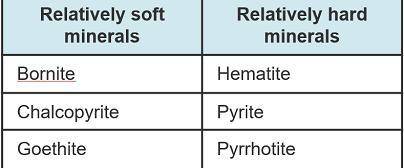
Gina's group classified their mineral samples based on relative hardness. They considered the minerals that have a hardness of less than five as relatively soft, and those with a hardness of five or above as relatively hard. They showed their groupings in a table.
A 2 column table with 3 rows. The first column is labeled Relatively soft minerals with entries: Bornite, Chalcopyrite, Goethite. Second column is labeled Relatively hard minerals with entries: Hematite, Pyrite, Pyrrhotite.
What does Gina’s group need to do to correct the information in the table?
Bornite needs to be switched with pyrite.
Pyrite needs to be switched with goethite.
Goethite needs to be switched with pyrrhotite.
Pyrrhotite needs to be switched with hematite.


Answers: 3
Other questions on the subject: Chemistry

Chemistry, 21.06.2019 22:30, bartfrank447
Joseph has hypothesized that sound travels in waves. if he were following the scientific method, what should he do next? a. ask a question. b. test the hypothesis. c. study the results. d. tell other scientists about his hypothesis.
Answers: 1

Chemistry, 22.06.2019 02:30, caeyanij
When svante arrhenius first proposed his acid-base theory, he was a doctoral candidate. his professors thought his ideas were unfounded. within a decade, the arrhenius theory of acid-base was widely accepted and praised within the scientific world. arrhenius defined acids as compounds having ionizable hydrogen and bases as compounds with ionizable a) barium. b) hydronium. c) hydroxide. d) oxygen.
Answers: 3

Chemistry, 22.06.2019 07:00, shradhwaip2426
Achemist wants to extract copper metal from copper chloride solution. the chemist places 0.50 grams of aluminum foil in a solution containing 0.75 grams of copper (ii) chloride. a single replacement reaction takes place. (ii) chloride. a single replacement reaction takes place. which statement explains the maximum amount of copper that the chemist can extract using this reaction? a) approximately 0.36 grams, because copper (ii) chloride acts as a limiting reactant b) approximately 1.8 grams, because copper (ii) chloride acts as a limiting reactant c) approximately 0.36 grams, because aluminum acts as a limiting reactant d) approximately 1.8 grams, because aluminum acts as a limiting reactant
Answers: 3

Chemistry, 22.06.2019 10:00, ellaemtagedeane
Nonpoint source pollution is difficult to control because it
Answers: 2
Do you know the correct answer?
Gina's group classified their mineral samples based on relative hardness. They considered the minera...
Questions in other subjects:

Mathematics, 13.10.2020 20:01


Arts, 13.10.2020 20:01



History, 13.10.2020 20:01


Mathematics, 13.10.2020 20:01


Social Studies, 13.10.2020 20:01






